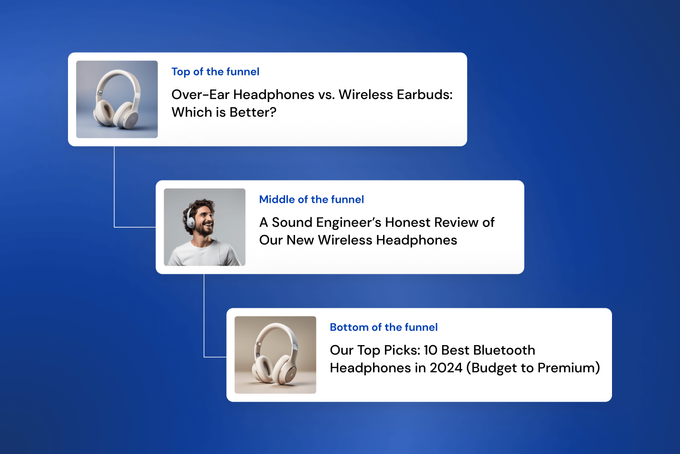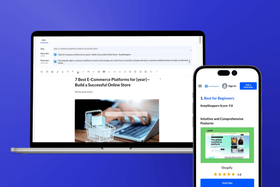Entail AI's unified approach to organic and paid content marketing
Balance organic and paid marketing strategies within a singular content funnel while testing and optimizing your content at scale.
Updated August 30, 2024

When it comes to digital marketing, understanding the connection between organic and paid strategies is essential. Contrary to popular belief, these approaches are not mutually exclusive. Rather, they work together within a unified content funnel.
In this guide, we'll delve into the intricacies of content marketing, exploring both organic and paid channels and how they come together to drive customer engagement and conversions in the sales funnel.
What's in this guide
- What is organic marketing?
- What is paid marketing?
- Getting to know the content marketing funnel
- Common challenges in the content marketing funnel
- A closer look at content exploration costs
- How Entail solves the challenge of testing content at scale
- Combining organic and paid strategies for optimal ROI
- Perfect your content funnel with a unified approach
What is organic marketing?
Organic marketing consists of non-paid efforts to attract and engage audiences. It relies on creating valuable content and optimizing it for distribution across multiple channels to promote online visibility without direct financial investment.
Common activities include publishing relevant and informative blog content regularly, actively participating in conversations on social platforms, and ensuring content is easily discoverable by search engines.
When conducting organic marketing efforts, organizations tend to focus on metrics related to engagement, organic reach, and conversions.
What is paid marketing?
Paid marketing relies on financial investments to achieve immediate visibility and reach a targeted audience. It includes strategies like pay-per-click (PPC) advertising, social media ad campaigns, and sponsored influencer content.
Important metrics to track throughout paid advertising efforts include click-through rate (CTR), cost per click (CPC), and return on ad spend (ROAS).
» Explore SEO vs. paid search approaches to conversion.
Getting to know the content marketing funnel
The content marketing funnel refers to the journey users take from brand awareness to conversion. You'll need to understand it to create authentic content that resonates with your audience at each stage.
Top of the funnel: Awareness
In the awareness stage, visitors are in a state of exploration and becoming acquainted with a brand or a particular topic. Here, you should align your content directly with user search intent.
You can create awareness with informative, engaging articles and visual content like social media videos, images, and infographics.
Middle of the funnel: Interest and consideration
Visitors in the middle of the funnel already know the brand, express interest, and consider available options. Content at this stage must provide more in-depth information on specific topics to build trust.
Useful content types include in-depth reviews, comparisons, case studies, and targeted tutorial-style videos.
Bottom of the funnel: Conversion
By the time a visitor reaches the bottom of the funnel, they're ready to make a decision. At this stage, your content should encourage them to take whatever the desired conversion action may be.
Bottom-of-the-funnel content can include demonstrations of your product or service, reviews, testimonials, or alternatives and should be rich in value-based calls to action.
» Learn how to perfect your conversion funnel.
Common challenges in the content marketing funnel
Most businesses follow a clear lifecycle when it comes to testing their creative content:
- Exploration: Identifying which types of content perform best across different platforms and funnel stages.
- Exploitation: Scaling that high-performing content to extract maximum value.
But there's such a vast amount of topics and content to test across distribution channels that it can be difficult to determine where to start investing these efforts and how to optimize your content accordingly.
Businesses often fail to solve this problem due to a variety of common challenges:
- Testing creative content at scale
- An over-reliance on paid formats in lower funnel stages
- Inefficient allocation of resources
- Failing to capitalize on effective content through scaling
How to solve these challenges
The first step to successful content marketing is becoming aware that you have customers that exist at different stages of the funnel at various points in time and knowing you want to drive them toward conversion.
The second step is spending less on exploration and more on the exploitation stage. That means focusing more on scaling the content that performs best.
A closer look at content exploration costs
At every stage of the content funnel, recurring costs ultimately affect the overall efficiency of your content marketing efforts.
Content creation costs
Content creation costs account for all of the activities involved in the physical production of high-quality content, including:
- Research to gather the necessary insights and supporting data
- Writing and design to produce engaging, visually appealing content
- Thorough editing to ensure accuracy and clarity
Operational costs
These costs involve the various resources required to create the content, whether human, material, or time. Related operations include:
- Effective content production process
- Team management and coordination
- Project management
Distribution costs
Distribution costs are naturally related to the spending associated with SEO and publishing your content across multiple channels. Due to the nature of content across different funnel stages, distribution costs tend to increase significantly as you move further down.
Bottom-of-the-funnel distributions often involve:
- Targeted outreach through paid channels
- Paid promotion and advertising
Optimizing your marketing investment
Given these costs, you need a strategic approach for organic and paid activities to generate the maximum return on investment.
By conducting the majority of exploration and exploitation activities in the top and middle of the funnel, and thus testing content at a lower distribution cost, you can spend less on content creation and operations, resulting in a more positive ROI.
How Entail solves the challenge of testing content at scale
Testing content at scale can be difficult. Our approach to optimizing content can help you overcome these challenges and get your content to your audience.
Conducting exploration and exploitation in the top and middle of the funnel
At Entail AI, we encourage businesses to avoid paid advertising in top and middle funnel levels and to test content at a lower distribution cost instead. This strategic approach minimizes costs while maximizing reach, particularly in the upper stages of the funnel.
Maximizing value at a low distribution cost is pivotal for a sustainable and efficient content marketing strategy and ensuring efficient resource allocation.
Optimizing content to meet potential customers where they are
It’s not only possible but crucial to generate revenue from top- and middle-of-the-funnel content.
We enrich content with interactive elements, custom widgets, and clear, value-based calls to action. This ensures that visitors, irrespective of their stage in the funnel, are nudged towards taking the desired conversion actions that align with your business objectives.
Leveraging organic insights to drive paid marketing efforts
Since most content exploration and scaling are conducted in upper funnel levels, businesses can gain lots of valuable insights before allocating resources to paid marketing efforts.
Insights from organic engagement provide helpful data you can use to make strategic decisions about refining and optimizing paid advertising strategies in lower-funnel stages.
» Explore how Entail solves every aspect of SEO.
Combining organic and paid strategies for optimal ROI
In content marketing, it's important to use organic and paid strategies together for the best results. These strategies work together within the same overarching content funnel.
Combining organic and paid methods is essential for businesses to maximize their reach, engagement, and return on investment.
Viewing organic and paid efforts holistically
Combining organic and paid marketing is an essential strategy. Understanding how these strategies work together helps you use each one's strengths to your advantage at different funnel stages.
Calculated content exploration and exploitation
You can scale your business's efforts more effectively by carefully matching your content to users' wants and using what we learn from organic engagement. This allows you to reach the right people with impactful content, which creates stronger relationships and increases sales.
Leveraging insights for optimal scaling
Learning from content performance is key to navigating effective content marketing. Knowing what resonates with your audience helps you make smart choices and focus on content that brings the best returns. Thriving in a dynamic market requires continuous analysis and adaptation to cater to ever-changing consumer needs and digital trends.
» Learn how to measure SEO ROI.
Perfect your content funnel with a unified approach
With the world of content marketing constantly evolving, companies can successfully navigate it by combining organic and paid strategies, guided by strategic insights and supported by innovative solutions such as a cutting-edge content management system and content strategy software.
This approach not only boosts visibility but also leads to authentic engagement and long-term conversions.
FAQs
Why is combining organic and paid strategies important in content marketing?
Organic strategies provide sustainable online visibility through valuable content, while paid strategies offer immediate, targeted reach. By combining them, businesses can engage a wider audience and maximize their impact on customer awareness, interest, and conversion across the marketing funnel.
Why is understanding the content marketing funnel important for businesses?
It allows you to create content that resonates with potential customers at different journey stages.
By raising awareness, providing detailed information, and encouraging conversions, you can tailor your approach to meet your goals and drive conversions.
How does Entail AI's CMS differ from other content management systems?
It provides a comprehensive solution, empowering businesses to efficiently produce, distribute, and test creative content at scale.
Unlike traditional CMS platforms, Entail's solution is designed to navigate the exploration phase with precision and solve the challenges associated with testing and optimizing creative content.






